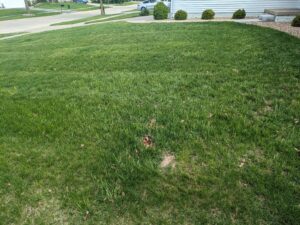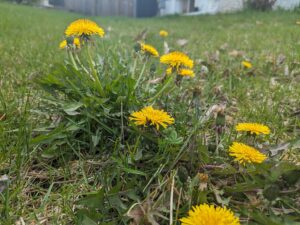What is No Mow May?

Imagine Jerry Seinfeld did a stand-up routine at an ecology conference. He might begin, in his iconic style, with a joke like “What’s the deal with No Mow May? Am I supposed to live in a jungle until June?”
You may have seen yard signs or heard neighbors declare they’re participating in the movement #NoMowMay, but what is it and how is it supposed to help the environment?
No Mow May started in 2019 by citizen scientists in the United Kingdom calling for homeowners to hold off on mowing for the month in order to allow grasses and weeds (such as dandelions and violets) to provide food and shelter for pollinators.
While the idea of providing habitat for pollinators is a powerful one (and one ICNC encourages), this call-to-action shouldn’t be taken too literally. There’s nothing magical about June 1st that makes it the perfect date to start mowing regardless of your climate or how much rainfall your yard receives during May.
Letting your yard go wild and then cutting it back all at once can actually be counterproductive to the health of your yard and the benefits that No Mow May is intended to provide to pollinators.
Believe it or not, the solution to creating more habitat for pollinators isn’t as simple as leaving your mower in the shed for another month.
Lawn Care for Pollinators

The No Mow May movement is right to question the lawn care norms that have destroyed pollinator habitats over the decades. The idea that lawns are supposed to be monocultures (consisting of a single species) removes pollinator food sources as well as natural beauty from our outdoor spaces.
No Mow May misses the mark by identifying mowing itself as the sole culprit when it’s really an under-appreciation of weeds that causes the most damage.
Many homeowners choose to avoid weeds, and weeding, by covering their lawns in chemical herbicides that kill weeds before they start. These chemicals deny pollinators food and shelter found in weeds that grow and bloom in the early spring when bees, butterflies and other essential pollinators emerge. We can embrace weeds on behalf of our pollinator friends without letting our yards go completely wild.
In fact, letting your yard go wild for a month and cutting it all down at once can confuse pollinators who have their bountiful food source simply disappear. A better way to ensure pollinators have a permanent food source in your yard would be planting a mini prairie.
Want to start small? Violets and dandelions are two pollinator-friendly plants that often can find their own way into a chemically-free yard and bring some bright colors to your landscape.
Visitors to violets include several kinds of bees like the mason bees, plus smaller butterflies, and pollinating flies. Violets are considered a butterfly-friendly plant because they are a major larva food source for the Fritillary butterflies. Some small mammals and birds eat the seeds of violets too.
In the early spring, dandelions serve as a primary food source for bees and other pollinators as they emerge after the winter season. Being among the first flowers to bloom, dandelions play a crucial role in providing bees with essential nectar.
How to do No Mow May right
Simple steps you can take to help pollinators without letting your yard become a jungle:
-
Welcome the weeds (and maybe a few weird looks)
First, stop putting chemicals on your lawn. Herbicides kill off many species of ‘weeds’ that are harmless to humans and helpful to pollinators. The longer your lawn remains chemical-free, the greater the diversity of pollinator-friendly plants that will begin growing in your yard. While your neighbors with manicured (and mostly lifeless) lawns give your yard the side eye treatment, you’ll be happy knowing you’re providing shelter and food for bees, butterflies and more. You may even find a certain beauty in the colors these ‘weeds’ bring to your space.
-
Mow for a healthier lawn
When it is time to mow, set your mower to its highest setting and leave it there. This setting allows dandelions and other flowering weeds to regrow, and it’s the healthiest way to cut your grass. Grass can go into shock and struggle to regrow if more than one-third of its height is cut. Letting your yard go wild during a rainy Iowa spring and cutting it all back at once would devastate your grass along with pollinator food sources.
-
Leave the Leaves
Try following a different hashtag movement: #LeavetheLeaves. This practice involves delaying your fall clean-up until the spring months. Leaves left on the ground create safe havens for pollinators to lay their eggs and hibernate during the winter months. If you let the leaves stay on the ground where they land until spring temperatures regularly reach higher than 50 degrees Fahrenheit, you will allow them time to emerge from dormancy.


3 Comments. Leave new
It’s now June, so I bag or not bag the clippings?
Hi Angie. Leaving the clippings can, over time, return more nutrients to your yard’s soil.
Thanks Eric!